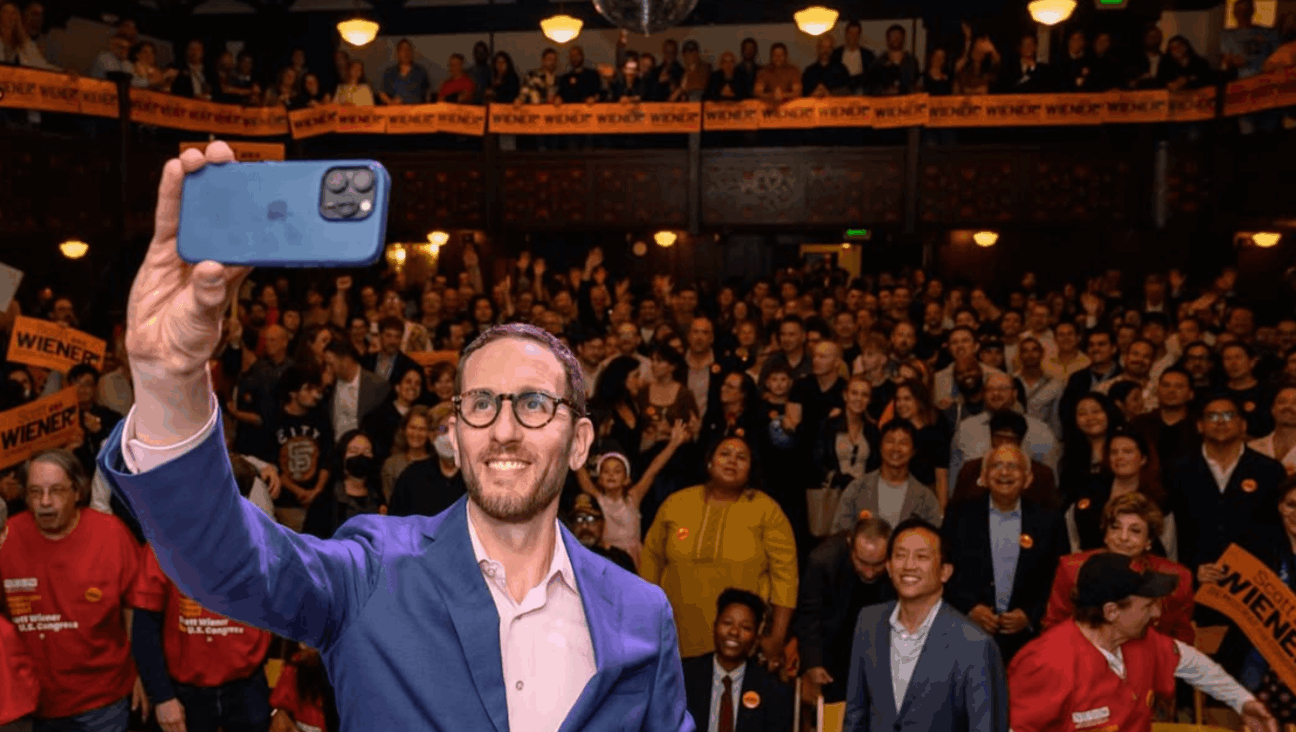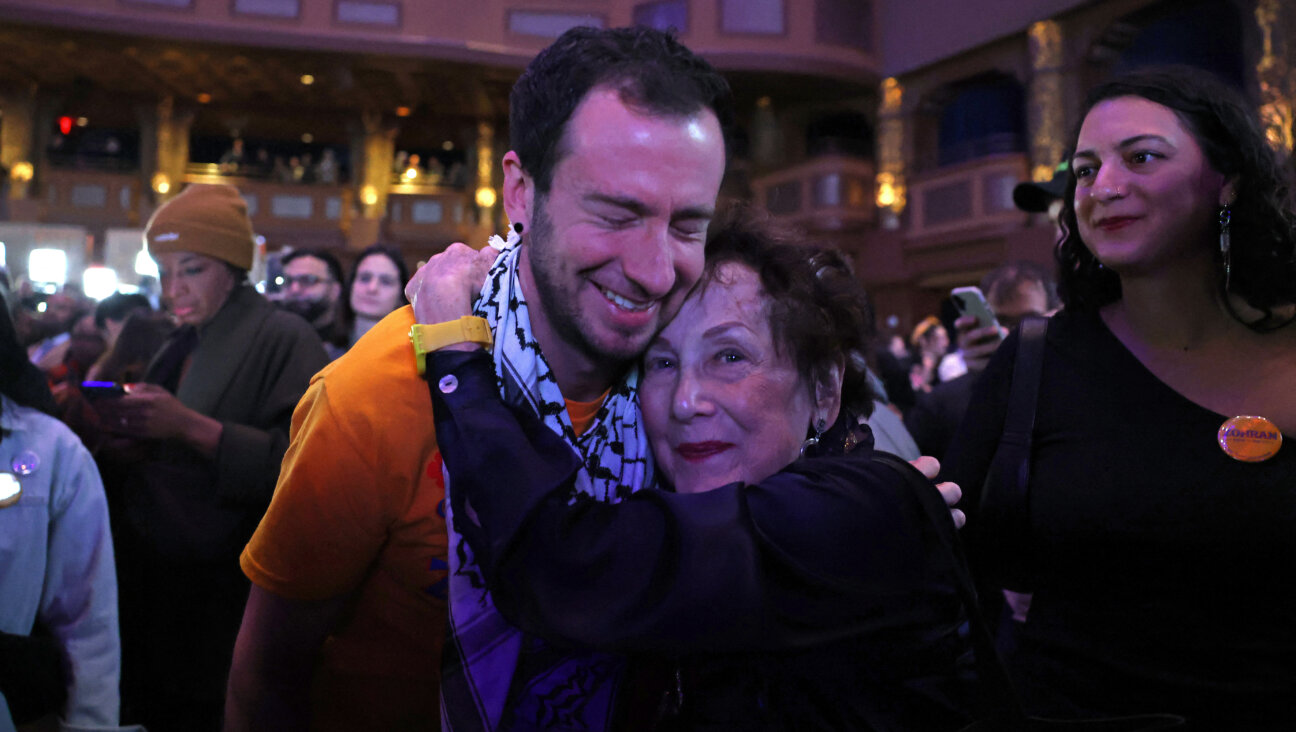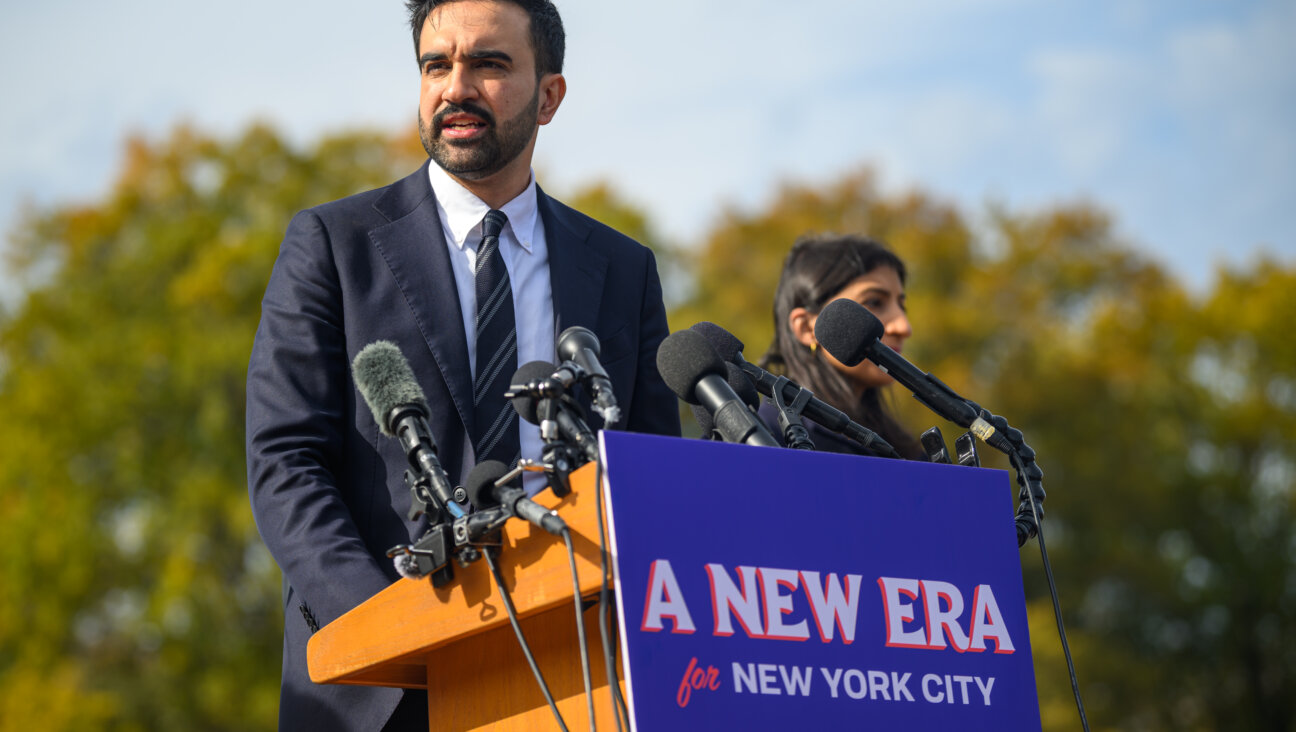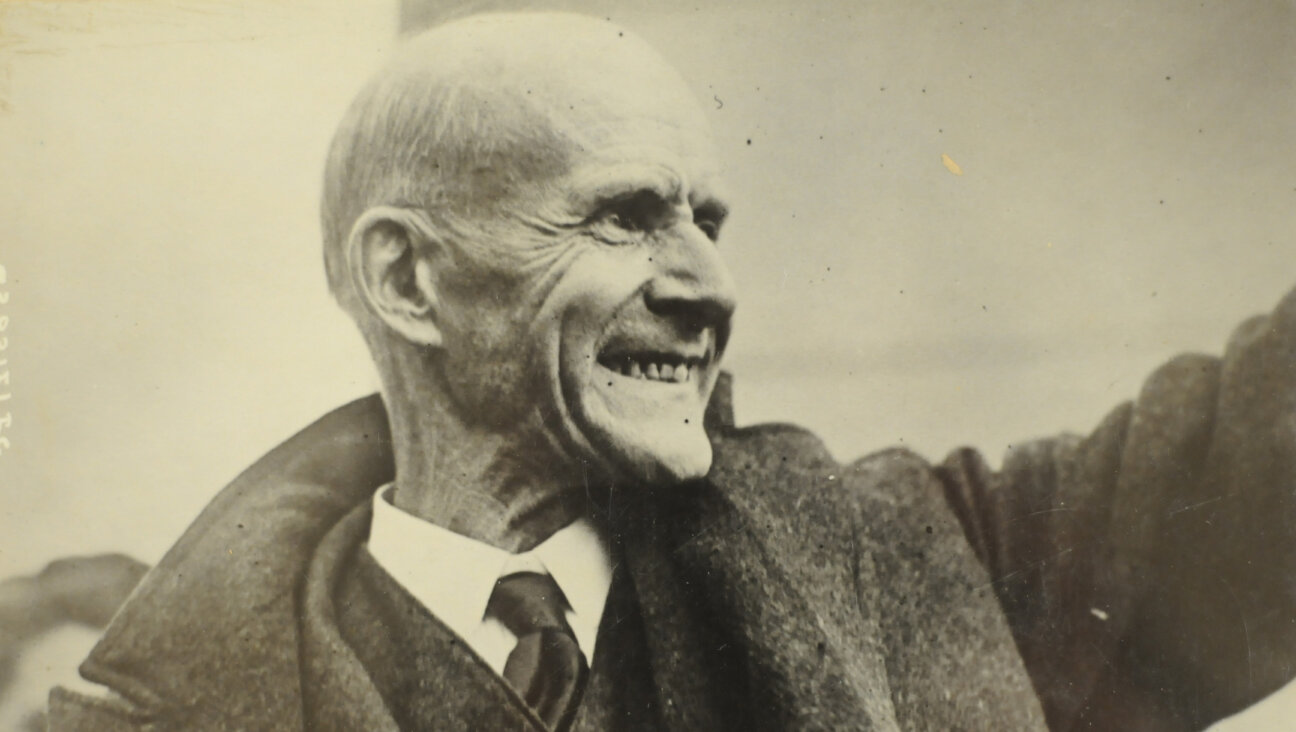The Jewish Woman with Journalism’s Biggest Job

Graphic by Angelie Zaslavsky

Anointed: Jill Abramson (left) in The New York Times newsroom following the announcement that she would succeed Bill Keller (center) as the paper?s executive editor. Looking on are Dean Baquet (far right), who will be the paper?s managing editor for news, and Abramson?s sister, Jane O?Connor (center right, in purple jacket). Image by fred R. Conrad/The New York Times/Redux
That Jill Abramson, the next executive editor of The New York Times, is Jewish does not distinguish her from many in the long line of top editors in whose footsteps she follows. Including her, four of the paper’s last six executive editors have been Jewish.
Yet, as the country’s most influential newspaper faces the critical challenge of surviving the reinvention of modern journalism, its leadership has chosen a top editor who is radically different from her predecessors in ways obvious (she is a woman) and subtle (she is actually kind of hip).
In her office in the corner of the third floor newsroom of The New York Times building, Abramson, who will assume the role in September, sat with her legs pulled up next to her and thought about how she would describe herself.
“Quirky,” she ventured.
In a sense, she isn’t so far off. Abramson, 57, had a New York City subway token tattooed on her arm when she was 49; speaks in a Dylanesque drawl, and has an affinity for indie music. Besides her investigative reporting and her work as an editor, she is best known for a Times blog she wrote about her puppy.
But while Abramson may not be a clone of the executive editors that came before her, those who know her say that her self-effacing description doesn’t fit.
“I don’t think she’s quirky,” said writer Amy Wilentz, who was her classmate at Harvard University. “She might be a quirky choice for The New York Times, but I don’t think Jill is really quirky. I think she’s stable. I think she’s reliable. I think she’s a good captain for stormy weather.”
Abramson, whose appointment was announced June 2, has been hailed, nearly universally, as an excellent choice for the exalted position. But she wasn’t exactly an obvious pick. “I think it’s fair to say there’s never been an executive editor of The New York Times quite like her,” said Peter Kaplan, former editor of the New York Observer, current editorial director of Condé Nast’s Fairchild Fashion Group and Abramson’s onetime Harvard buddy.
Though an accomplished investigative reporter, Abramson, unlike current executive editor Bill Keller and all his recent predecessors, has never been a foreign correspondent. Most were also Times lifers who deeply absorbed the Times’ unique culture as they rose through the ranks. But Abramson came to the Times after years as a reporter at other publications, and rose to Washington bureau chief after only three years. She was named the Times’ managing editor for news just three years after that.
Abramson could not be more different from her predecessor, at least in their public personae. Keller’s humorless image was cemented in a disastrous 2009 interview with Jason Jones of “The Daily Show,” when he stumbled haplessly into punch line after punch line. Classically handsome, with silver hair and a regal posture, Keller looks like a bank president.
Abramson is also elegant, but slyly ironic. A picture of Keith Richards and a framed New Yorker cover of a family of King Kongs eating lunch in front of the Empire State Building hang on her office walls. A shelf over her desk is filled with books about dogs. She has her own dog book due out in October.
Many consider the position she will take on to be the most exalted in the media industry. But Abramson learned otherwise on May 23, just hours after an early-morning phone call from Arthur Ochs Sulzberger Jr., the publisher, who offered her the opportunity to succeed Keller.
Sulzberger called from Europe as Abramson was leaving her home to meet Keller and Times art critic Holland Cotter at the Metropolitan Museum of Art for a private tour of the blockbuster exhibit of the work of the late fashion provocatuer Alexander McQueen. Visitors were waiting more than an hour to get in on weekends, and Abramson wasn’t about to miss the date, even if she had just been appointed to the top berth of the newspaper of record.
The gallery was relatively quiet as the exhibit’s curator, Andrew Bolton, showed the trio around. Then, word came that Vogue editor and fashion kingmaker Anna Wintour had arrived. Bolton was gone.
It was a good moment for her and Keller to be put in their place, Abramson said, laughing, in an interview.
Friends and colleagues speak about her distinctive decisiveness. She doesn’t procrastinate, and she doesn’t dither. And her decisiveness lends her a sort of serenity that seems out of place in a person with such great responsibilities.
“If you have ever been in the Times, you know there’s a tremendous sense of vastness about it,” said Gay Talese, a onetime Times reporter and the author of “The Kingdom and the Power,” a seminal history of the paper. “All these people wandering around, doing a million things. She’s aware of everything, but you never get the impression that she is concerned about anything. She’s so calm. It’s as if she’s running a flower shop.”
Today, the Times is unabashed about the Jewishness of many of its most high-profile staffers and executives. But that was not always so. For the better part of a century, the Times did all it could to obscure its significance as a paper owned by Jews, one based in a world center of Jewish life, and written and edited by many Jews.
In the 1940s, Jews like Abraham Raskin, who eventually became the Times’ top labor reporter and an assistant editorial page editor, used their first initials in their bylines to hide their obviously Jewish first names. More seriously, the paper severely underplayed the Holocaust, in part due to its fear of being perceived as a paper lobbying for specifically Jewish interests.
The newspaper was “influenced in the war years by the management’s overriding desire not to be perceived as a special pleader for Jews,” former Times executive editor Max Frankel wrote in an e-mail to the Forward. “Therefore accounts of the murder of Jews, even when credible, were not featured in the news columns and, all too often, simply subsumed in general, non-ethnic references to ‘victims.’”
The Sulzberger family, which has long owned the paper, “were Jewish, yes, they never denied it,” Talese said. But the German-Jewish Sulzburgers didn’t identify with the country’s newer Eastern European Russian-Jewish arrivals, he said. “And they didn’t want [the Times] to be a Jewish newspaper, because it was an American newspaper.”
According to former Times managing editor Arthur Gelb, the paper’s decisive turn came in 1963, when Arthur Ochs Sulzberger, father of the paper’s current publisher, became publisher.
“He didn’t give a damn what an editor’s background was,” Gelb said. “The question was, was he good.”
Abramson’s own Jewish identity is of a very particular kind. In an early version of the Times’ own story on her promotion, Abramson declared that “the Times substituted for religion” in her childhood home — a quip that drew fire from some right-wing commentators. But in fact, her upbringing was typically Jewish, in an Upper West Side-in-the-’60s sort of way. The first year that family members decided to light a menorah on Hanukkah, the candles singed their Christmas tree.
Both of Abramson’s parents were born into upper middle-class Jewish families in Manhattan. Norman Abramson ran a family textile-importing firm called Irish Loom Associates; his wife, Dovie, was a housewife, but one who had an undergraduate degree from Barnard College and who had begun but not completed a master’s in political science at Columbia University.
Their children inherited her intellectual bent. Abramson’s sister, Jane O’Connor, is the author of the wildly successful Fancy Nancy picture book series. The books follow a quirky, verbally precocious young girl named Nancy who likes to dress up in “fancy” clothes and use “fancy” words. Asked whether she or her sister inspired Nancy’s verbal precocity, O’Connor said they both did.
Though the family did not belong to a synagogue, O’Connor was interested in Judaism as a child and asked to be sent to Sunday school at Temple Emanu-El on Manhattan’s Upper East Side. The first year she attended, O’Connor decided that the family needed to celebrate Passover. She told her grandmother, who bought haggadot and set up the ceremony.
“After the Seder was finished, a big basket of hot rolls was brought out,” O’Connor laughed. “But she was well-intentioned.”

Image by richard caplan
Abramson declined to answer questions about her current religious practice. But she was educated at the Ethical Culture Fieldston School, a tony prep school historically connected to the New York Society for Ethical Culture. Founded in the late 19th century by the son of a prominent Reform rabbi, the society and Fieldston itself have been historical redoubts for secular Jews.
Students took classes in ethics throughout elementary and high school. Abramson remembers her third grade ethics teacher, Florence Klaber, as “the essence of goodness.” On her blackboard, Klaber would write, “Do the ends justify the means?” The question had a lasting impact.
“We were constantly being pitched moral dilemmas by her and trying to separate the ends and means, and answer that question, which for a small child is powerful,” Abramson remembered.
Decades later, in a 2004 speech to students at her former school, Abramson said that the memory of Klaber sticks with her in the newsroom.
“As managing editor of the Times, I have had to deal with requests from the government not to publish sensitive stories dealing with national security,” she said. “I always remember the question that Mrs. Klaber scrawled on the blackboard, because it is a very good test. In some cases, when a story appearing in the newspaper will put someone’s life in danger, I have to weigh whether the story is so important that it is worth such a terrible risk.”
After graduating from Fieldston, Abramson went on to Harvard, where she was part of a shifting group of friends that at times included Kaplan; Wilentz, who was her sophomore year roommate, and Times TV critic Alessandra Stanley.
“She was kind of bourgeois hip, if you know what I mean,” said Kaplan. “She dressed well; she talked, like, Jill talk, Jill speak.”
“Jill talk,” a sort of slow, intellectual drawl, is an enduring puzzle. The accent is very New York, but at the same time a bit peculiar. It could be a Central Park West accent, if such a thing exists. Abramson jokingly called it a Fieldston accent, though O’Connor has it, too, and she attended a different private school.
Wilentz had the best explanation: “Bob Dylan affected all of us, and a lot of us talked a little like Bob Dylan. The speech pattern is a little bit ironic and a little bit cynical sounding, a little bit tough and hard-bitten.”
Today, Abramson ventures to the city’s hipper neighborhoods to see bands associated with her son, Will Griggs, co-founder of the Brooklyn music label Cantora Records. Asked about her own taste in music, she cited Francis and the Lights, a band on her son’s label that plays a retro-style indie pop.
Abramson and her cohort graduated from college as the values of the counterculture were falling out of fashion. “The earth was opening up underneath you, and your left foot was in 1969 and your right foot was in 1976,” Kaplan remembered. But if the counterculture was losing its cachet, opportunities for women were expanding rapidly. O’Connor, who is six years older than her sister, said that when she graduated from Smith in 1970, no one in her circle was thinking seriously about careers. Abramson’s far more directed attitude toward her career reflected an enormous generational shift.
Before coming to the Times, Abramson proved herself at legal trade magazines owned by Steven Brill. She then made her way to The Wall Street Journal, where she reunited with Jane Mayer, a fellow Fieldston alum whom Abramson had first befriended when the two worked as campus stringers for Time magazine. The women decided to collaborate on a book about the stormy confirmation hearings for Supreme Court justice nominee Clarence Thomas, who was strongly backed by the conservative movement.
“For us it was a baptism,” Mayer said of the partisan attacks that greeted the publication of their book “Strange Justice.” The book confirmed Senate testimony by former Thomas aide Anita Hill that Thomas had sexually harassed some of his employees. “With a false step we could have ended up badly.” Mayer credited Abramson with painstakingly rebutting charges of partisanship and showing that the two had the story right.
Abramson, who came to the Times in 1997, became Washington bureau chief in 2000. She had that New York City subway token tattooed on her shoulder when she was called back to New York in 2003 to take the managing editor post. It was the same year that the MetroCard became the only way to get on the subway. The token’s warning, “Good for one fare,” is as close as she gets to a life philosophy, she said.
Her return to New York came at a particularly difficult moment. Howell Raines, the paper’s executive editor, had lost the confidence of the newsroom and resigned in the wake of the Jayson Blair plagiarism scandal. Abramson was widely depicted at the time as one of Raines’s staunchest opponents.
“There was carnage everywhere,” Kaplan said.
Then the Internet revolution arrived, and with it the loss of classified ads, causing the Times, along with many other papers, to bleed revenue. The paper plunged deep into the red.
In their eight years together, Keller and Abramson have gotten the paper back on course. But the going hasn’t been easy. Buyouts in 2009 shook the newsroom. The new pay wall on the paper’s website has been called a provisional success, but long-term prospects for making a profit on the Internet remain questionable.
Those who have known Abramson for years are confident she can shoulder the responsibility.
“When your generation gets the chance to offer somebody to do something extraordinary, you hope they’ll offer somebody great,” Kaplan said. “I’m delighted that she is the person my generation has offered up to be editor of The New York Times.”
Contact Josh Nathan-Kazis at [email protected] or on Twitter @joshnathankazis















